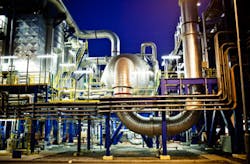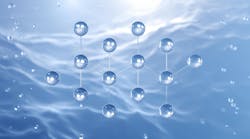By combining thermal distillation with membrane filtration, hybrid desalination projects are helping to reduce project carbon footprints and energy operation costs – as much as $400 million per year in some instances. Although dating back to the early 90s, technology advances today are now showing why this technology pairing might pave the way for future desalination plants.
By Leon Awerbuch
Like many new technological ideas, it took over 20 years to see hybrid systems implemented on a large scale and adopted by the desalination industry, today primarily located in the Middle East Gulf States.
The hybrid desalting concept is the combination of two or more processes in order to provide better environmental solutions and a lower water cost product, compared to each standalone process by itself.
Dual purpose power-desalination plants make use of thermal energy extracted or exhausted from power plants in the form of low pressure steam to provide heat input to thermal desalination plants for multistage flash (MSF) or multi-effect (MED) distillation processes. The electrical energy can be also effectively used in electrically-driven desalination processes like Reverse Osmosis (RO) and Vapor Compression Distillation (VCD).
Early suggestions for hybrid desalination were based upon elimination of the requirement for a second pass to the RO process so that the higher-salinity RO product could be combined with the better quality product from a MSF plant. This is the simplest application of hybrid desalination. Since then, other concepts have been proposed for hybrid desalination. Today, although RO can produce potable total dissolved solids (TDS) in one pass, blending allows a simple solution where national standards require low levels of boron.
The hybrid system received significant attention recently with implementation of desalination and power plants at Fujairah I and Fujairah II in the United Arab Emirates (UAE), Ras Al -Khair in Kingdom of Saudi Arabia and Az-Zour South in Kuwait. This is as well as the current ongoing competition for hybrid of power and MSF-RO or MED-RO desalination Station D in Qatar.
Energy conservation using hybrid systems
In view of the dramatic concern with global climate conditions and a rise in fuel prices in excess of US$90 per barrel, hybrid (RO + distillation) systems offers significant savings in fuel costs in comparison with the distillation-only option.
In the base case for a 455,000 m3/day MSF desalination and 400 MW of electric power generation plant, the fuel consumption is 191 tons/hr and the annual cost requirement will exceed US$735 million. By comparison, a hybrid 455,000 m3/day desalination plant based on 60% thermal and 40% RO will operate at reduced fuel consumption of only 115 tons/hr. This equates to a cost of US$443 million per year.
This hybrid system reduces the carbon dioxide footprint by 40%, and the annual fuel cost difference is almost 300 million per year, which will pay back for the total Capex of desalination in less than three years. Of course, in the base case, we produce more power, and to some extent, this compensates for the additional cost – but this assumes that we need the power.
In many countries, particularly in the Middle East, peak power demand occurs in summer and then drops dramatically to 30-40%. In contrast, the demand for desalinated water is almost constant throughout the year. This creates a situation where over 50% of power generation is not used. This inequality of demand between electricity and water can be corrected by diverting the excess of available electricity to water production.
There is also the challenge that water can be stored, while electricity storage is not practical. In this case, excess electricity can be diverted to water production incorporating electrically-driven Seawater Reverse Osmosis (SWRO) and/or Vapor Compression with the low-pressure steam-driven technology of MSF or MED. One method of making use of idle power capacity is the use of electrically driven RO or VCD plants in combination with Desalination Aquifer Storage Recovery (DASR) both for averaging the desalination capacity, for strategic and economic fresh ground water storage or improving quality of the region groundwater basins.
Hybrid – the New Alternative
In the simple hybrid MSF/RO or MED/RO desalination power process, a seawater RO plant is combined with either a new or existing dual purpose thermal desalination/power plant, resulting in the several advantages, including extending RO membrane life.
In general, the hybrid idea allows part of the distillation plant's heated coolant reject to be de-aerated, using low-pressure steam from the distillation plant (to reduce corrosion and residual chlorine), and used as the feed to the SWRO plant. The higher temperature of the feed improves membrane performance (flux, at constant pressure, increases by 1.5–3% for each degree C).
This is particularly important during the winter, when seawater temperatures can drop to as low as 15°C. The MSF or MED plant's distillate, at less than 20 ppm TDS, is blended with the SWRO plant's product, making it possible to meet potable water standards for maximum TDS and chloride concentrations with higher SWRO plant product salinity. This, in turn, means that the SWRO plants can be operated at higher conversion ratios, warmer seawater is reducing consumption of energy and chemicals and extending membrane useful life. In one variant of the "classic scheme," the SWRO plant's reject brine becomes the feed to the MSF or MED plant particularly if the seawater is softened by Nanofiltration membranes, utilizing its high pressure, with a turbocharger, to boost the MSF plant's recirculation pump. By doing this, the conversion ratio of the hybrid NF/SWRO+ MSF/MED plant is significantly increased.
Membrane Performance as a Function of Seawater Temperature
For all membranes, water permeability (i.e., permeate production) declines with operating time, while product salinity and chloride concentration increase.
The drop in production can, with time, be compensated by installing extra membrane rack space and installing additional membranes as required. The increase in product salinity cannot be compensated for except with large scale membrane replacement. In the case of hybrid systems (RO + distillation), a single pass RO system can be specified while maintaining a long membrane life.
This is made possible by blending the RO product water with the high purity distilled water produced by the thermal desalination unit.
The use of all or some of the preheated seawater cooling water discharge from a thermal desalination plant as feed to a SWRO plant enables elevating and controlling the SWRO plant's operating temperature at its optimal or any other higher desired value. As important eliminates need for built new intake and outfall structure as demonstrated by 30 MIGD Seawater RO expansions in Fujairah I and Kuwait Az-Zour South plants.
Feed water temperature affects the two main performance characteristics of a membrane: flux and salt rejection. Higher feed water temperatures increase not only flux but also salt passage. For all membranes, water production is a function of temperature, at constant feed pressure. Production will go up with temperature increasing by 1.5% to 3% per degree Celsius for nearly all membranes, thereby enabling reduction of the number of RO membrane modules required for a given permeate capacity. This is, of course, contingent on feed water of sufficient quality so that membrane fouling rate will not increase during operation at higher flux. The results imply that the energy consumption of RO can be reduced using a simple integration of MSF/RO hybrid arrangement in which the RO plant is fed the preheated seawater rejected from the MSF heat rejection section.
It is quite obvious that higher recovery can be obtained with lower salinity feed, which has clear process implications when we consider Nanofiltration in front of RO system or the use of blending seawater feed with lower salinity water (concentrate of brackish RO, for example) to lower the feed salinity to RO system.
Higher membrane permeability at elevated temperature may also result in a higher recovery rate. However, higher feed water temperature and recovery rate are associated with an increase of osmotic pressure. The permeate TDS systematically increases as the feed temperature and recovery rate are increased. Fortunately, this salinity increase can be easily compensated in hybrid systems (RO + thermal desalination unit) where the ratio of distilled water to membrane permeate can be controlled to achieved required product TDS.
The increase of recovery rate at constant feed pressure at increased temperature in a RO hybrid system leads to reduction of specific power consumption. Some critics of higher temperature of operation of RO and NF membranes suggest higher rate of fouling due to increased biological activities. The increase of seawater temperature, which is happening inside the condenser or rejects section of the distillation plant, is being achieved in a matter of seconds. The assumption is that this rapid rate of temperature increases results in a thermal shock, possibly reducing biological activity in seawater feed to the membrane unit.
Another issue of concern is the compaction of membrane material (permeability decline) during long-term operation at high feed pressure and elevated temperature. Today maximum temperature for continuous operation for most of the membrane is 40º C, but clearly we need membranes capable for continuous operation above 50º C. Such membranes for seawater will be developed in view that in summer in some places of the Gulf like in Dubai, the DEWA (Dubai Electricity and Water Authority) plants the intake seawater can exceed 42º C.
Hybrid Using Nanofiltration - Membrane Softening
Today, pioneering work on Nanofiltration membrane NF softening technology as applied to desalination processes and specifically to seawater desalination is under development by two groups: Leading Edge Technologies Ltd (LET) and the Saline Water Conversion Corporation (SWCC) of Saudi Arabia.
The great potential of Nanofiltration membrane softening technology was brought to focus by a recent award by Sharjah Electricity and Water Authority (SEWA) to LET and Besix Consortium for the first commercial LET Nanofiltration System to increase the capacity of an existing MSF plant from nominal 22,7000 m3/day to 32,800 m3/day. This 40%+ increase in capacity of MSF unit was a result of a two-year demonstration and simulation program developed jointly with SEWA.
NF membrane softening technology could significantly improve operation and reduce the cost of the MED process, by eliminating the risk of scaling and fouling. NF technology will permit an increase in the top temperature resulting in a significant increase in output and the performance ratio.
Renewable Powered Desalination
This brings me to a discussion of use of renewable energy and in particular solar energy in combination with advanced desalination plants. MASDAR in Abu Dhabi, KA CARE (King Abdullah City for Atomic and Renewable Energy) in Saudi Arabia and many R&D centers around the world are developing technologies to substitute fossil fuel, minimized carbon footprint and reduce cost of desalination.
One such proposal targets advanced MED combined with solar energy. The MED process operates only with top brine temperature at 64°C to 75°C depending on salinity of the seawater to avoid scale deposition on heat transfer surfaces. Therefore the energy supply can be at low temperature in form of hot water or hot brine at less than 90°C or steam at low .35 bars pressure. Therefore the only electrical energy required is for running the process pumps will be less than 1.4 kWh/m3.
Resource conservation and environmental impact are aspects that have to be considered when designing hybrid systems The reduced primary (fuel) energy consumption when coupling reverse osmosis with thermal processes in a hybrid configuration conserves from 30% up to 40% against reference plants (boiler for heat and condensing turbine power plant for electricity).
CO2 emissions from a gas-fired combined cycle plant with a corresponding SWRO share are, likewise, substantially lower than for a conventional cycle. Showing a substantial reduction is dissipation of heat from a hybrid plant to the sea as compared with the conventional heat cycle/SWRO configuration.
In recent years, the consideration of carbon dioxide footprint will have a significant impact in justifying hybrid plants in the Gulf. Many of the existing distillation plants are approaching the design life of 25 years. Owners have to consider life extension with additional upgrading in the capacity and efficiency of the desalination plants.
New technologies using Nanofiltration, softening membranes of seawater and integrated upgrading of distillation plants can raise top operating temperature and increase the design production from existing plants by over 40%. Such rehabilitation and upgrading minimizes the environmental impact and produces more critically needed water without building new intake –outfall structures and new power plants.
Combining thermal and membrane desalination processes and technologies within a single plant or in hybrid plant schemes can reduce desalinated water costs, in dual-purpose stations; add flexibility and better match the demand to the combined water and power production; and, most importantly, minimize the environmental impact of power desalination plants.
Leon Awerbuch is president of Leading Edge Technologies and a director of the International Desalination Association, Dean of IDA Desalination Academy and Co-Chair of IDA's Technical Programs. He holds 28 patents and disclosures and has published over 90 technical papers. Email: [email protected]
***************
Case Studies of Existing Plants
Jeddah Hybrid
The first straightforward hybrid plant scheme has been adopted in Jeddah I and II in Saudi Arabia to blend higher TDS RO permeate with distillate from existing MSF plants. The results of conceptual and design work led to construction of the simple hybrid project at Jeddah 1, phase I and II plants. The Jeddah 1 RO plant is 30 mgd (113,600 m3/day) combining Phase I, which has been operated since 1989, and Phase II, which has been operated since March 1994. The plant is owned by Saline Water Conversion Corporation (SWCC), design by Bechtel, and constructed by Mitsubishi Heavy Industries, Ltd. The operation and analysis of the plant, which utilized Toyobo Hollosep double element type hollow fiber RO modules, indicate that the life of the membrane was extended to over 10 years. In addition to 136,380 m3/dayRO permeate, the Jeddah complex produces 363,380 m3/day distillate from Jeddah II, III and IV and 924 MW electricity. Jeddah I RO plant successfully adopted an Intermittent Chlorine Injection method (ICI) in order to prevent membrane degradation by oxidation reaction and biofouling.
Fujairah II
The largest hybrid MED-RO plant is the Fujairah II desalination project was constructed by SIDEM and Veolia and provides 591,000 m3/day of water. The Greenfield development is also producing 2000 MW of power. It will use five high-efficiency Alstom GT26 gas turbines in combined cycle mode and 12 SIDEM 37,730 m3/day Multi Effect Distillation desalination units with a RO desalination plant.
Ras Al- Khair
The largest operational desalination plant in the world had previously been the 880,000 m3/day Shoaiba 3 thermal desalination plant in Saudi Arabia. This was displaced in April 2014 when the Ras Al-Khair hybrid plant went on stream. As the world's largest seawater desalination plant, for which Doosan won the construction order in September 2010 from the Saline Water Conversion Corporation, the Ras Al-Khair plant produces 1,036,000 m3/d, sufficient to meet the daily water requirements of around 3.5 million people. The plant produced its first freshwater earlier this year, although the project was actually scheduled for completion in December 2015. As the world's largest hybrid plant, the project uses both membrane technology (reverse osmosis, RO at 309,360 m3/day) and thermal technology (multi-stage flash evaporation, MSF with a capacity of 727,130 m3/day). This plant also features the largest single MSF trains composed of eight units with capacity of over 91,000 m3/day each. The RO plant has 17 trains. The Ras Al-Khair plant is dual purpose with an export production capacity of 1.025 million m3/day desalinated water and an electricity production capacity of 2,400 MW, providing 1350 MW for the Maaden Aluminum Complex, 1050 MW to the Saudi Electricity Company, and about 200MW for internal consumption on site.
Facility D Hybrid by Kahramaa in Qatar
The bids are submitted for the latest IWPP hybrid project by Qatar General Electricity and Water Corporation-Kahramaa. The facility shall be designed for a facility power in the range between 2400 MW ±5% and for a facility water capacity to be in the range between 591,000 m3/day ±5% out of which 182,000 to 273,000 m3/day to be with RO desalination technology and balance with MSF/MED technology. This would be the highest percentage of RO in Hybrid system underscoring the optimum balance between .membrane and thermal processes. This would be the latest demonstration on large scale of hybrid benefits.
More Water & WasteWater International Archives Issue Articles




